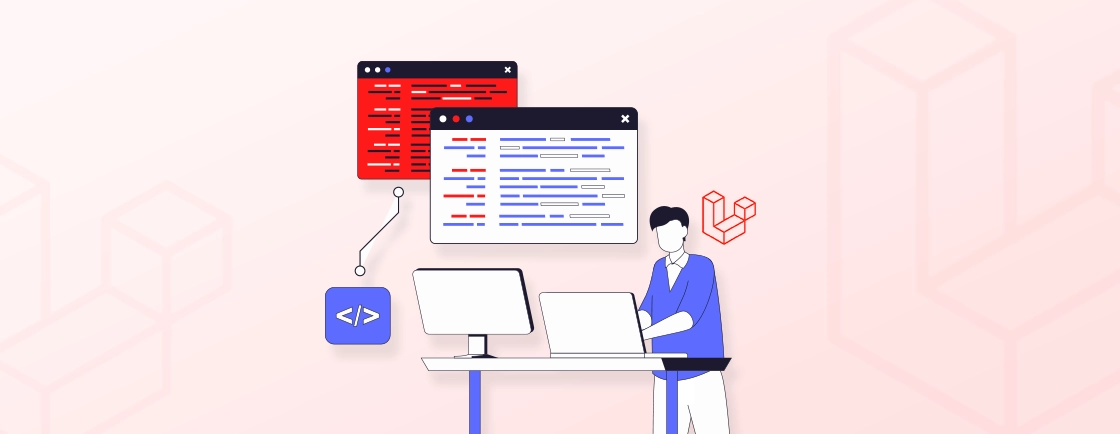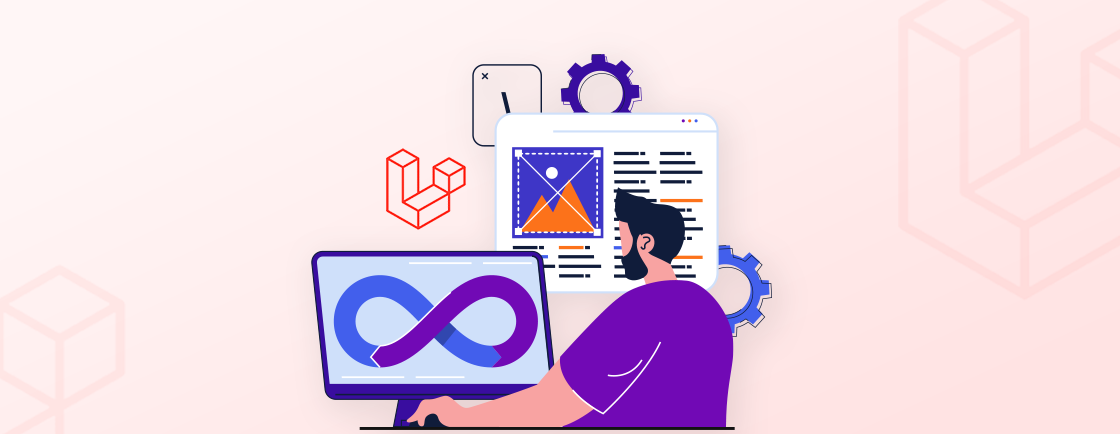Table of Contents
Ever felt stuck trying to manage more than one database in a Laravel project? Maybe you’ve got user data in one database and product info in another. Or maybe you’re working with a legacy system and can’t move everything into a single place. I know that-it gets messy fast.
Running queries, syncing data, and keeping everything smooth-it’s a headache.
But here’s the good news-Laravel makes it super easy to connect multiple databases. You just need to know the right way to set things up. In this blog, we’ll show you how to connect multiple databases without complicating them. Let’s get into it!
Why Use Multiple Databases in Laravel?
Sometimes, a single database isn’t enough to handle the structure or needs of a growing application. You might be dealing with legacy systems, need to isolate data, or want to improve performance by splitting things up.
Laravel makes it possible to connect to and use several databases without complicating your workflow.
There are several practical reasons for using multiple databases in a Laravel application:
- Multi-Tenant Applications: Each tenant can have its own database.
- Modular Architecture: Different modules (e.g., orders, users, analytics) can use separate databases for better performance and isolation.
- Migration from Legacy Systems: Access data from an older database while building a new one.
- Security and Compliance: Store sensitive data separately as required by regulations.
Using multiple databases isn’t just about handling more data-it’s about better organizing your application and giving it room to grow. With Laravel’s flexible configuration, you get the control to scale smartly and securely.
Laravel’s Database Configuration
Before working with Laravel multiple databases, it’s important to understand how the framework handles database settings. Laravel uses a clean and centralized approach for managing connections, making it easy to define and switch between them.
All connection configurations are stored in the config/database.php file. By default, Laravel supports various drivers like MySQL, PostgreSQL, SQLite, and SQL Server. You can define multiple connections under the connections array. For each connection, you can specify the driver, host, port, database name, username, and password.
Understanding this setup lays the foundation for using Laravel multiple databases effectively. Once you’re familiar with where settings go and how to access them, managing separate connections becomes much more straightforward. Lastly, maximize performance and consistency for data spanning multiple connections, follow the best tips to optimize Laravel database queries for smooth querying and reporting.
How to Configure Multiple Database Connections?
When your project needs to talk to more than one database, Laravel gives you the flexibility to set up multiple connections with just a few changes.
Note: When configuring multiple database connections, particularly with MySQL, it’s important to understand Laravel MySQL strict modesettings. Strict mode enforces stricter data validation and can affect how queries behave across different database connections.
This setup allows your application to pull or write data across different databases without much extra code.
To set up multiple databases:
1. Open config/database.php
2. Add a new connection under the connections array:
'mysql2' => [
'driver' => 'mysql',
'host' => env('DB2_HOST', '127.0.0.1'),
'port' => env('DB2_PORT', '3306'),
'database' => env('DB2_DATABASE', 'forge'),
'username' => env('DB2_USERNAME', 'forge'),
'password' => env('DB2_PASSWORD', ''),
'charset' => 'utf8mb4',
'collation' => 'utf8mb4_unicode_ci',
'prefix' => '',
],

3. In your .env file, add:
DB2_HOST=127.0.0.1
DB2_PORT=3306
DB2_DATABASE=second_db
DB2_USERNAME=root
DB2_PASSWORD=secret
With the connections in place, your application is now ready to communicate with each database as needed. Laravel’s structure keeps things organized, so switching between databases or managing data from different sources becomes simple and reliable. Using Laravel File Storage ensures your app can organize, retrieve, and protect files stored in both legacy and new databases.
Using Multiple Databases in Eloquent Models
Once your database connections are configured, the next step is telling your models which one to use. Laravel’s Eloquent ORM makes this process simple by allowing you to specify the connection directly in each model.
This gives you control over where your data is coming from or going to.
To associate a model with a specific connection:
class Report extends Model
{
protected $connection = 'mysql2';
protected $table = 'reports';
}
This tells Laravel to use the mysql2 connection when querying the reports table.
By setting the connection in your models, you make sure each one interacts with the correct database. It keeps your code clean and helps avoid confusion when managing data across multiple sources.
Query Builder with Multiple Connections
Not every task needs an Eloquent model. Sometimes, you just want to run quick, flexible queries. Laravel’s query builder works smoothly with multiple connections, letting you target specific databases by calling the right connection before your query.
You can use Laravel’s query builder to run queries on specific connections:
$users = DB::connection('mysql2')->table('users')->get();
This is useful for dynamic or read-only data access.
With this approach, you can keep your logic efficient and focused, especially when working across different databases. Laravel handles the rest, keeping things consistent and easy to maintain.
Migrations and Seeders for Multiple Databases
Handling Laravel migrations across different databases might seem tricky, but Laravel makes it manageable. You can run migrations and seeders for specific connections by using a few simple commands.
This allows you to structure and populate each database independently without affecting the others.
To run migrations on a specific connection:
php artisan migrate --database=mysql2
You can also specify the connection in your migration file:
public function __construct()
{
$this->connection = 'mysql2';
}
By running migrations and seeders on the right connections, you keep each database organized and in sync with your application’s needs. It adds flexibility to your development process and helps maintain clean, separate data structures.
Transaction Management Across Databases
When working with more than one database, handling database transactions in Laravel becomes more complex. Laravel allows you to manage transactions on individual connections, but coordinating them across multiple databases requires extra care to maintain data consistency and avoid errors.
Each connection manages its own transactions. Laravel does not support distributed transactions across multiple databases.
If needed, you must handle rollbacks manually in a try-catch block:
DB::connection('mysql')->beginTransaction();
DB::connection('mysql2')->beginTransaction();
try {
// Perform operations
DB::connection('mysql')->commit();
DB::connection('mysql2')->commit();
} catch (\Exception $e) {
DB::connection('mysql')->rollBack();
DB::connection('mysql2')->rollBack();
}
Managing transactions this way helps ensure that each database handles its part correctly, even when operations span across systems. While cross-database transactions need attention, Laravel’s tools give you enough control to keep things stable and predictable. After configuring multiple databases, explore how to upload images in Laravel to handle user images and documents across your connections.
Common Pitfalls and Troubleshooting
Working with multiple databases in Laravel offers flexibility, but it can also lead to some tricky situations. From misconfigured connections to unexpected query results, small oversights can create big issues.
This section highlights the common problems developers face and how to fix them before they cause larger headaches.
- Connection not found: Ensure it’s defined in database.php.
- Wrong credentials: Double-check your .env variables.
- Model uses wrong connection: Explicitly define $connection in the model.
- Cached config: Run php artisan config:clear after changes.
By being aware of these common pitfalls early on, you can save time and avoid unnecessary debugging. A little attention to detail during setup and testing goes a long way when working with multiple databases in Laravel. Integrate Laravel file upload functionality with your various databases to securely manage documents, avatars, and other files for each module or tenant.
Conclusion
Working with multiple databases in Laravel might sound tricky at first, but once you get the setup right, it’s actually pretty smooth.
Whether you’re splitting data for better performance, handling legacy systems, or just keeping the data organized — Laravel gives you the tools to handle it all easily. Just keep things clean, double-check your connections, and don’t forget to test.
And if you need professional help with connecting multiple databases, reach out to a Laravel development company for the best outcomes.
FAQs for Laravel Multiple Databases
How do I define multiple database connections in Laravel?
You can define multiple connections in the config/database.php file under the connections array. Each connection can have its own driver, host, database, username, and password.
Can I use different models for different databases?
Yes, by assigning a specific $connection property in each model, you can link it to a different database connection defined in your configuration. Always run regular Laravel MySQL dump backups before syncing data or migrating schemas across databases in a complex Laravel project.
Can I use database seeding in Laravel for multiple databases?
Yes, you can use database seeding in Laravel to populate different databases independently. Use the –database flag with the db:seed command.
Build Powerful Laravel Applications
Learn how to leverage Laravel's powerful features for efficient and scalable web development.





